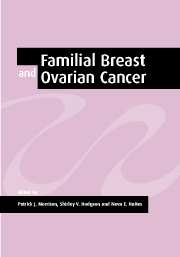Book contents
- Frontmatter
- Contents
- List of contributors
- Foreword by Helena Kennedy
- Preface
- Acknowledgements
- Part 1 Molecular biology and natural history
- Part 2 Screening
- Part 3 Management
- 15 Management of BRCA1/2 mutation carriers
- 16 Management of familial ovarian cancer
- 17 Prophylactic mastectomy in mutation carriers
- 18 Psychosocial aspects of genetic counselling for breast and ovarian cancer
- 19 BRCA1/2 testing: uptake and its measurement
- 20 Breast cancer genetics: ethical, social and insurance issues
- 21 Gene therapy for breast and ovarian cancer
- 22 Future directions
- Index
16 - Management of familial ovarian cancer
Published online by Cambridge University Press: 24 August 2009
- Frontmatter
- Contents
- List of contributors
- Foreword by Helena Kennedy
- Preface
- Acknowledgements
- Part 1 Molecular biology and natural history
- Part 2 Screening
- Part 3 Management
- 15 Management of BRCA1/2 mutation carriers
- 16 Management of familial ovarian cancer
- 17 Prophylactic mastectomy in mutation carriers
- 18 Psychosocial aspects of genetic counselling for breast and ovarian cancer
- 19 BRCA1/2 testing: uptake and its measurement
- 20 Breast cancer genetics: ethical, social and insurance issues
- 21 Gene therapy for breast and ovarian cancer
- 22 Future directions
- Index
Summary
Should the management of familial ovarian cancer differ from that of sporadic ovarian cancer?
The management of familial ovarian cancer (FOC) is currently essentially the same as for sporadic ovarian cancer, but is FOC biologically different from sporadic ovarian cancer and should we be managing it differently?. There is some conflicting evidence. Greggi examined eight families with two or more first-degree relatives affected with epithelial ovarian cancer (EOC) among a series of 138 consecutive ovarian cancer patients. No significant difference was detected in clinical and pathological features between sporadic and familial cases. Papillary serous adenocarcinoma was the predominant histological type. However, in three high-risk families, EOC tended to develop at a younger age compared with other familial cases and with sporadic cancers, and nulliparity was less frequent in the familial group (Greggi et al., 1990). Similarly, Bewtra identified 37 FOC patients from FOC syndrome kindreds with documented cancers of the ovary, breast, colon or endometrium in two or more first-degree relatives. The age and clinical stage at diagnosis and overall 5-year survival of FOC patients were compared with those of sporadic EOC patients. The mean age of FOC patients at diagnosis was significantly lower (50.2 years) than that of the unselected control population (59 years) (P<0.00.1). Histologically, all (100%) FOC tumours were EOC, with a predominance of serious papillary type, moderate to high grade (89 vs 71% in control; P=0.07). No other pathological features appeared to be significant (Bewtra et al., 1992).
- Type
- Chapter
- Information
- Familial Breast and Ovarian CancerGenetics, Screening and Management, pp. 275 - 285Publisher: Cambridge University PressPrint publication year: 2002
- 1
- Cited by



